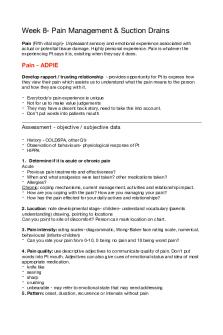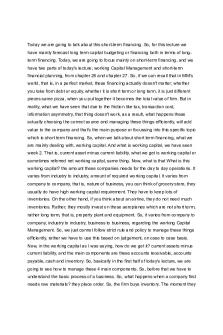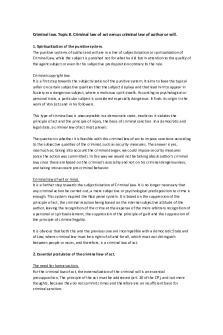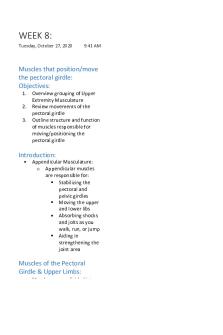Lecture 8 Notes PDF

| Title | Lecture 8 Notes |
|---|---|
| Course | Altered Physiology 3- Cancer Biology |
| Institution | University of Ontario Institute of Technology |
| Pages | 3 |
| File Size | 51.4 KB |
| File Type | |
| Total Downloads | 96 |
| Total Views | 145 |
Summary
Lecture 8 Notes...
Description
Lecture 8: Cancer Treatment *common bile duct Challenge with surgery? Breast cancer surgery, chemo, bilateral Rad and chemo in cycles Check slide for radiation effects Colonm lung, renal, gliblastoma for avastin PD1
Can we cure cancer? No so what is the goal? Chalening why? 2 graphs we discuss when looking at cancer challenges in treatment Know the graphs. So whats the point with the 1st one? o So based on first graph. First treatments should be? o Problem with reoccurence? o So what is the normal approach to treamtent? 2nd graph says minumal residual disease. Also importance of pairing treatments with diagnostic and monitirong tools to detect early recurrence Surgical Oncology First treatment for cancer Works for what? Doesn’t work for? Challenging because? Also metastasis 80%? Thus surgery only affective locally. 4 Principles of Surgical oncology? o 1st, clear resection margins? o 2nd, early diagnosis? Usual combo? o 3rd, access? o 4th minimize damage? Ex Colon cancer o Colon cancers vary in location, thus they can be treated with colectomies, removing part of colon. Temporary colestomies can bemade. But ideal is saving part of rectum and having 2nd surgery to attach it to healthy part of colon. o Problems? Metastasis? Gastric cancer ex o Billroth o Can u survive without stomach? So partial gastrectomy o Common site for gastric adenomas? Antrum. Bad if its invading here because? If pancrease affected, what needs to be saved? MRIs o Billiroth 2? neutral o Challenge then? Breast cancer ex o Not only surgical impact, but also? This is in old approach masectomy. 1950s Radical masectomy? Aggressive, 2-3 decades? Bilateral? Edema? Pectroral?
o
o
Chemo too Simple masectomy, 60s Chemo 70s, studies? Local invasive ductal carcinomas. Lumpectomy Can we do just tumor. Not too diff from simple masectomy Mammogrpahy. Upper outer quadrant Too conservative?
Chemotherapy MED and MTD Chemo good cuz idea of oral/injected drug killing all cancer cells in bidy Can be pre or post surgery. (preadvent for pre) So with drugs, doctors ask what dosage is rqeuried to get the effect they want, kill canacer cells. MED. But also then how far can they go before damaging normal cells, MTD. Therapeutic window o Cuz toxic to normla cells too Small for chemo drugs, big for things like aspirin. Cycles Select Cytotoxic drugs o So question is what to target with chemo drugs? o Book on cancer, serendipitous? o Problems with targetting DNA synthesis? Which are side effect o Alkylating agents What do? Examples? o Platinum compounds Heavy metals. What do? Examples? o Antimetabolites What do? Examples? o Mitotic inhibitors? What do? Target? Examples? Vis o Used in combos because? Efficacy Toxicity Resstance Nucleic acid and protein targets o So most drugs came about in latter 20th century o Note ones on slide, can search em up if on test. Just ex of previous drugs talked about o Development od new durugs is also very complex and systematitic Recall RCT trail phases, phase 1, 2, and 3 Each diff for diff drug, drug combo, stage Big problem with chemo? Drug resitsance o Problem cuz cancer such adaptable cells o Mechanisms? Drug efflux transporters? Decreased activiation
o o
Detoxify Dna repair Apoptosis Should chemo be accompanied by efflux transporter inhibtors? Bacteria. Microbiolgoists + cancer biologists?
Radiotherapy
Physical. Radiation is mutagenic. Focus? Grpah similar shown. Small therapeutic window. Cant just bombard entire abdomen Main thing to consider then is dose. So cycles again Many adverse effects, which are commonly seen o Acute effects occur in prolioferating tissue, mainly inflammation. Cytstitis, proctitis, hair loss, bone marrow supression, dematitis, mucostitis o Late effects? 6 Infertility. 2nd malignancies Particle acceleratos and magents used to fire beam and allign it to one specific location. Rad not only affects path, but surrounding area too. So need to be precise and minimize damage Brachytherapy, prosstate Other therapies One new type of approach is antibodies, with monoclonal antibodies, targeting of specific cancer related molecules o BCR-Able o HER2 o VEGF o CTLA-4 o ER Another therapy is to inhibit growth factor signlaining o Done for ex with 3 drugs we talked about. Gleevec, Herceptin, Tamoxifen o Can have pic open for exam**** Inhibition of angiogenesis o Mechanisms already explained, like avastin blocking VEGF. So used in cancers with high angiogenesis like colon, lung, renal, glioblastomas. o Problem? Immune checkpoint blockade o Concept same as CTLA4 and Also PD1. same thing o That with immune responses, there are checkpoints to keep things in order. Remove that and u can remove the breaks and let immune system act o Immunotherapy Inhibition of hormone receptors o Normally tamoxifen competitivte antagonist that inhibits ER receptors in breast cancer o Attempts to reduce cancer risk preemptively? o Problem in 90s tho is that it can bind to ER in breaast, but also uterus! Here its ligand o Came out concept that drugs /antibodies should consider all possible receptors of that type in body...
Similar Free PDFs

8 - Lecture notes 8
- 21 Pages

8 - Lecture notes 8
- 21 Pages

8 Midwifery - Lecture notes 8
- 3 Pages

Taxation 8 - Lecture notes 8
- 2 Pages

Week 8 - Lecture notes 8
- 6 Pages

Dox 8 - Lecture notes 8
- 21 Pages

Lesson 8 - Lecture notes 8
- 2 Pages

Assignment 8 - Lecture notes 8
- 4 Pages

Week 8 - Lecture notes 8
- 23 Pages

WEEK 8 - Lecture notes 8
- 10 Pages

CL-8 - Lecture notes 8
- 12 Pages

Tema 8 - Lecture notes 8
- 8 Pages

Lesson 8 - Lecture notes 8
- 19 Pages

Chapter 8 - Lecture notes 8
- 7 Pages

Chapter 8 - Lecture notes 8
- 2 Pages

Chapter 8 - Lecture notes 8
- 7 Pages
Popular Institutions
- Tinajero National High School - Annex
- Politeknik Caltex Riau
- Yokohama City University
- SGT University
- University of Al-Qadisiyah
- Divine Word College of Vigan
- Techniek College Rotterdam
- Universidade de Santiago
- Universiti Teknologi MARA Cawangan Johor Kampus Pasir Gudang
- Poltekkes Kemenkes Yogyakarta
- Baguio City National High School
- Colegio san marcos
- preparatoria uno
- Centro de Bachillerato Tecnológico Industrial y de Servicios No. 107
- Dalian Maritime University
- Quang Trung Secondary School
- Colegio Tecnológico en Informática
- Corporación Regional de Educación Superior
- Grupo CEDVA
- Dar Al Uloom University
- Centro de Estudios Preuniversitarios de la Universidad Nacional de Ingeniería
- 上智大学
- Aakash International School, Nuna Majara
- San Felipe Neri Catholic School
- Kang Chiao International School - New Taipei City
- Misamis Occidental National High School
- Institución Educativa Escuela Normal Juan Ladrilleros
- Kolehiyo ng Pantukan
- Batanes State College
- Instituto Continental
- Sekolah Menengah Kejuruan Kesehatan Kaltara (Tarakan)
- Colegio de La Inmaculada Concepcion - Cebu